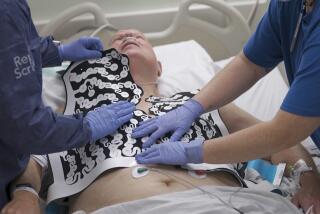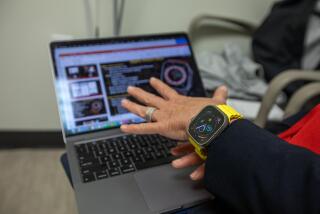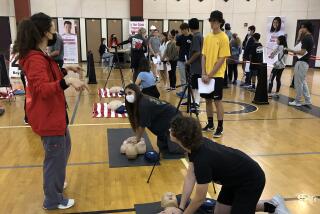Study Says Heart Defibrillators in Body Save Lives
- Share via
Implanting miniature defibrillators into the chests of people who have survived heart attacks is much more effective than drugs at keeping the patients alive and can save thousands of lives every year, researchers report today.
A multi-center team sponsored by the National Institutes of Health studied 1,016 heart attack survivors; half received defibrillators and half got drugs designed to prevent disturbances in heart rhythms. The devices sense when heartbeats become erratic and automatically deliver a tiny jolt of electricity to reestablish a normal rhythm.
The researchers report today in the New England Journal of Medicine that after one year there were 39% fewer deaths among those who received the electrical devices, and 31% fewer after three years.
An estimated 350,000 Americans suffer a heart attack each year as a result of life-threatening arrhythmias. About 5% to 10% survive the heart attack and would be candidates for an implanted defibrillator.
The defibrillator “is like having an emergency room implanted in your chest,” said Dr. Douglas Zipes of the Indiana University School of Medicine, who was chairman of the study group. “The device will monitor your heart rhythm and respond with appropriate therapy.”
The results of the study were so conclusive, in fact, that the trial was stopped in April, 16 months ahead of schedule, so that defibrillators could be offered to those in the drug group.
A second trial reported in the same issue of the New England Journal of Medicine, however, suggested that the electrical devices are not useful in some patients who have not had a heart attack. In that study, defibrillators were implanted in patients who underwent coronary artery bypass surgery in an effort to forestall subsequent heart attacks. That study was also stopped prematurely, but in this case because the electrical devices provided no benefit.
Implantable cardioverter-defibrillators, or ICDs, are pager-sized versions of the electrical paddles routinely used to shock an arrhythmic heart back into normal rhythms. But because their electrical leads are attached directly to heart muscle, they can achieve their purpose with a minuscule jolt of electricity.
The titanium-encased ICDs, which weigh a little more than 5 ounces, are implanted under the skin in the upper chest in a $66,000 operation. They have rubber-coated titanium leads that travel through veins to the right ventricle of the heart. A battery in the device lasts about nine years before it must be surgically replaced.
A microcomputer in the device keeps a record of irregular heart activity so that it can be analyzed by a cardiologist after an episode.
An estimated 125,000 Americans have received an ICD to correct irregular heart rhythms, but there have previously been few studies to demonstrate their effectiveness.
“We’ve known for some time that these devices stop arrhythmias and restore normal heart rhythm, but it has not been known--until now--whether they improve overall survival,” said Dr. Claude Lenfant, director of the National Heart, Lung and Blood Institute.
About half of the patients in the study had ventricular tachycardia, in which the heart suddenly starts racing. The rest had ventricular fibrillation, in which the heart beats erratically without pumping blood. All had been resuscitated after a previous heart attack.
In the study, 507 of the patients received an ICD, while 509 received an anti-arrhythmic drug, either amiodarone or sotalol. Patients in both groups also received other drugs as necessary.
Each surgical team used its own favorite brand of device, because ICDs from different manufacturers are generally assumed to be equivalent.
At the end of one year, 89.3% of the patients who had received an ICD were still alive, compared to 82.3% of those receiving only drugs. After three years, the figures were 75.4% and 64.1%. That translates to 39% fewer deaths after one year among those who received ICDs, and 31% fewer after three years.
Dr. David Steinhaus of St. Luke’s Hospital in Kansas City, Mo., had one patient whose life was saved by the device while he was grocery shopping.
“He had an episode of sudden cardiac death and passed out on the grocery cart,” Steinhaus said. “The device shocked him. He just stood up, wiped himself off, went through the grocery line and called us a bit later.
“What’s exciting about this is that the patient would have died otherwise,” Steinhaus said.
In the second study, reported by a team headquartered at Columbia University, ICDs were implanted in half of 900 patients who underwent a bypass. The surgical patients all had abnormalities in heart rhythms and the team hoped to prevent heart attacks caused by arrhythmias after the surgery.
But after 32 months of follow-up, there were 72 deaths from heart disease in the group who received ICDs and 71 in the control group. The study was halted in April.
(BEGIN TEXT OF INFOBOX / INFOGRAPHIC)
Life-Saving Device
Miniature defibrillators implanted in the chests of heart attack survivors sense erratic heartbeats and automatically deliver a tiny jolt of electricity to reestablish a normal rhythm.
Implantable Cardioverter-Defibrillator (ICD)
* MORE HELP FOR HEARTS: A surgical procedure involving a back muscle can help strengthen failing hearts. B2






